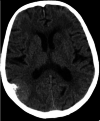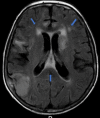Neurosyphilis: The Great Imitator
- PMID: 36686118
- PMCID: PMC9851570
- DOI: 10.7759/cureus.32747
Neurosyphilis: The Great Imitator
Abstract
Syphilis is a sexually transmitted disease caused by spirochete Treponema pallidum, with a growing incidence documented in recent years. Its clinical course is divided into three phases - primary, secondary, and tertiary syphilis - and virtually any organ can be affected, resulting in diverse clinical manifestations, making the diagnosis challenging. Neurosyphilis is a progressive, destructive disease of the central nervous system (CNS) that can develop at any stage of the infection, leading to meningeal involvement, meningovascular disease, or parenchymal syphilis (including tabes dorsalis and general paresis). Its clinical manifestations are heterogeneous and vary from focal neurologic signs to neuropsychiatric manifestations. The diagnosis is based mainly on the clinical picture and study of cerebrospinal fluid. Neuroimaging is helpful and sometimes essential, with magnetic resonance imaging being the most sensitive radiologic method, although there are no pathognomonic radiologic signs. Treatment of all forms of neurosyphilis is based on parenteral penicillin. We present a case of neurosyphilis in a patient presenting with a subacute confusional state and initial imaging findings suggestive of metastatic CNS lesions.
Keywords: acute confusional state; autoimmune limbic encephalitis; cns lesions; neurosyphilis; paraneoplastic encephalitis syndromes.
Copyright © 2022, Jancar et al.
Conflict of interest statement
The authors have declared that no competing interests exist.
Figures


Similar articles
-
Analysis of Neurosyphilis Imaging Methods and Treatment: A Focused Review.Cureus. 2024 Nov 4;16(11):e72976. doi: 10.7759/cureus.72976. eCollection 2024 Nov. Cureus. 2024. PMID: 39640117 Free PMC article. Review.
-
Neurosyphilis.2024 Apr 21. In: StatPearls [Internet]. Treasure Island (FL): StatPearls Publishing; 2025 Jan–. 2024 Apr 21. In: StatPearls [Internet]. Treasure Island (FL): StatPearls Publishing; 2025 Jan–. PMID: 31082023 Free Books & Documents.
-
[Neurosyphilis in Psychiatric Settings: Three Case Reports].Turk Psikiyatri Derg. 2017 Spring;28(1):61-66. Turk Psikiyatri Derg. 2017. PMID: 28291299 Turkish.
-
Imaging features of neurosyphilis.J Neuroradiol. 2023 Mar;50(2):241-252. doi: 10.1016/j.neurad.2023.01.003. Epub 2023 Jan 11. J Neuroradiol. 2023. PMID: 36641134 Review.
-
[Syphilis: uncommon presentation forms].Medicina (B Aires). 2023;83(6):976-980. Medicina (B Aires). 2023. PMID: 38117717 Spanish.
Cited by
-
Analysis of Neurosyphilis Imaging Methods and Treatment: A Focused Review.Cureus. 2024 Nov 4;16(11):e72976. doi: 10.7759/cureus.72976. eCollection 2024 Nov. Cureus. 2024. PMID: 39640117 Free PMC article. Review.
-
Novel and characteristic radiological features of neurosyphilis: a case series.BMC Neurol. 2024 Jul 20;24(1):248. doi: 10.1186/s12883-024-03762-5. BMC Neurol. 2024. PMID: 39033301 Free PMC article.
-
The performance of a novel diagnostic criteria for neurosyphilis in HIV-negative patients.Sci Rep. 2024 Dec 28;14(1):31171. doi: 10.1038/s41598-024-82477-6. Sci Rep. 2024. PMID: 39732770 Free PMC article.
-
Secondary Central Nervous System Demyelinating Disorders in the Elderly: A Narrative Review.Healthcare (Basel). 2023 Jul 25;11(15):2126. doi: 10.3390/healthcare11152126. Healthcare (Basel). 2023. PMID: 37570367 Free PMC article. Review.
References
-
- Jameson JL, Fauci AS, Kasper DL, Hauser SL, Longo DL, Loscalzo J. Harrisons Principle of Internal Medicine. Vol. 19. New York, NY: McGraw Hill; 2017. Harrisons Principle of Internal Medicine; pp. 1132–1138.
-
- Syphilis hospitalisations in Portugal over the last decade. Sousa-Pinto B, Freitas A, Lisboa C. Eur J Clin Microbiol Infect Dis. 2016;35:169–174. - PubMed
-
- Neurosyphilis. Ropper AH. N Engl J Med. 2019;381:1358–1363. - PubMed
-
- Mesiotemporal T2-weighted hyperintensity: neurosyphilis mimicking herpes encephalitis. Bash S, Hathout GM, Cohen S. https://pubmed.ncbi.nlm.nih.gov/11156776/ AJNR Am J Neuroradiol. 2001;22:314–316. - PMC - PubMed
Publication types
LinkOut - more resources
Full Text Sources
